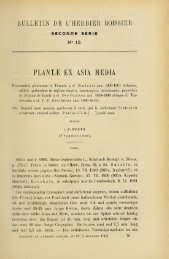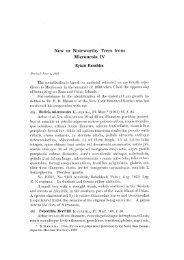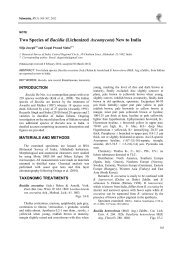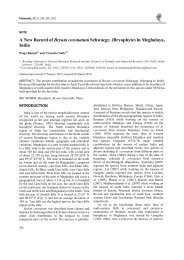Full text (PDF) - 國立臺灣大學
Full text (PDF) - 國立臺灣大學
Full text (PDF) - 國立臺灣大學
You also want an ePaper? Increase the reach of your titles
YUMPU automatically turns print PDFs into web optimized ePapers that Google loves.
, 2013 Huang et al.: Remusatia yunnanensis newly recorded in Taiwan<br />
Gonatanthus yunnanensis H. Li & A. Hay, Acta Bot.Yunnan.<br />
14 (4): 375. 1992. -Type: China, Yingjiang County, Li 9107<br />
(type. KUM)<br />
Seasonally dormant monoecious herbs forming<br />
bulbils or tubers, epiphytes; tubers red outside, white<br />
inside, globose, ca. 3–8 cm in diam. Bulbiferous stolons<br />
1–3, creeping or pendulous, ca. 500 × 8 mm, internodes<br />
3–6 cm long. Bulbils ellipsoid, 1–5 mm in diam.,<br />
enclosed by 8–15 hooked scales. Leaves 2–3, ovate,<br />
15–45 cm long, 10–25 cm broad, apex acuminate, base<br />
cordate, margin entire, leaf blade pale green abaxially,<br />
green adaxially; base peltate and cordate, petioles<br />
cylindrical, 20–60 cm long; primary veins 4 or 5<br />
radiating from the petioles, secondary venation arching.<br />
Inflorescences 1–3, flowering with leaves; peduncle<br />
green, cylindrical, 11–17 cm long. Spathe leathery,<br />
spathe tube green, ovate-elliptic, ca. 3 × 1.2 cm, apex<br />
strongly constricted; spathe limb initially erect, later<br />
spreading and soon reflexed, light purple red within and<br />
dull purple red beneath, base yellow on both surfaces,<br />
obovate-oblong, ca. 8.5 × 3 cm. Spadix: female zone<br />
subcylindric, ca. 15 × 6 mm, densely flowered; stigma<br />
sessile, circular; female flowers 4-carpellate; ovary<br />
1-loculed, green, ovoid, ca. 2 mm; ovules many, basal,<br />
suberect; sterile zone yellow, ca. 14 mm, slender; male<br />
zone yellow, broadly cylindrical, ca. 17 × 4 mm,<br />
attenuate toward base, apex obtuse; synandria of 4 or 5<br />
fused stamens, filament obconic, apex truncate; thecae<br />
8–10, obovoid, adnate to outside of filament and<br />
opening by a terminal pore. Fl. Aug–Oct. 2n = 28.<br />
Specimens examined: TAIWAN, Nantou County,<br />
Shuanglong logging tract, ca. 1250–1300 m in elevation, C. T. Huang<br />
1183 (TAI).<br />
Phenology: Bloom period from August to October.<br />
Distribution: Taiwan (Shuanglong logging tract) and<br />
China (Tongbiguan, Yingjiang co., Yunnan).<br />
Ecology: Moss-laden boughs, growing on tree<br />
trunks in rain forests, mountain slopes at elevation ca.<br />
1200–1300 m, mixed evergreen forests, semi-open<br />
environment, often cloudy in the afternoon.<br />
DISCUSSION<br />
One diagnostic character used for distinguishing R.<br />
yunnanensis from R. vivipara has relied on the<br />
observation that the former has creeping bulbiferous<br />
stolons whereas the latter seems to always have erect<br />
bulbiferous stolens. However, after careful examination<br />
of herbarium records and living plants of R. vivipara in<br />
the field, both creeping and erected bulbiferous stolons<br />
have been found (Fig. 4). Li and Boyce (2010) reported<br />
R. yunnanensis flowers during leaf development while<br />
R. vivipara flowers before leaf initiation. Contrary to<br />
this, herbarium specimens of R. vivipara examined in<br />
this study show that flowers may develop before or<br />
Fig. 1. Distribution map of Remusatia yunnanensis in<br />
Taiwan.<br />
during leaf development (specimen examined, KUM<br />
Tao 16931). Moreover, their flowering time overlaps<br />
according to the Flora of China (i.e. August to<br />
September in R. yunnanensis and April to September in<br />
R. vivipara flowers) (Li and Boyce, 2010). An updated,<br />
detailed comparison of the morphological characters of<br />
R. vivipara and R. yunnanensis is shown in Table 1.<br />
Our discovery of R. yunnanensis based on its purple<br />
red spathe reveals a disjunct distribution between<br />
Yunnan and Taiwan. R. vivipara rarely produces<br />
flowers in the field and no fruits with fertile seeds were<br />
found in any herbarium record. In order to induce<br />
flowering during cultivation, we raised the tubers<br />
collected from Shuangling logging tract. Intriguingly,<br />
two individual tubers had flower coloration showing<br />
purple red spathe limbs instead of yellow, as observed<br />
from the other tubers we raised. After performing a<br />
preliminary cytology check (2n = 28, see introduction),<br />
we suspect R. yunnanensis is a diploid form of R.<br />
vivipara. In support of this hypothesis, the phylogeny of<br />
Remusatia has revealed that R. vivipara and R.<br />
yunnanensis were clustered in the same group, with<br />
identical chloroplast region sequences (Li et al., 2012).<br />
Taken together, it is quite likely that R. yunnanensis is a<br />
diploid parent of the triploid R. vivipara.<br />
ACKNOWLEDGEMENTS<br />
We are grateful to Mr. Xin-Jie Hong for collecting R.<br />
vivipara. Sincere thanks to Mr. Wei-Yu Wang, who provided<br />
the photo of R. yunnanensis. We also thank Dr. Heng Li for<br />
her clear exposition of the Remusatia and the curator of KUM<br />
herbarium for facilitating specimen examination.<br />
LITERATURE CITED<br />
Cusimano, N., J. Bogner, S. J. Mayo, P. C. Boyce, S. Y.<br />
Wong, M. Hesse, W. L. A. Hetterscheid, R. C. Keating<br />
and J. C. French. 2011. Relationships within the<br />
77








